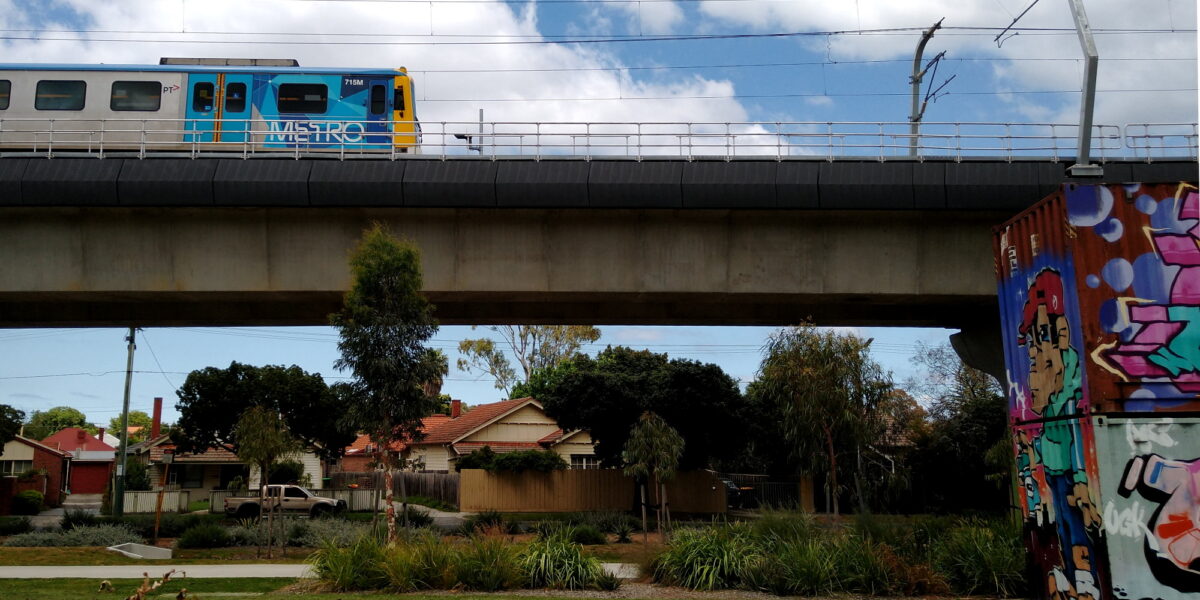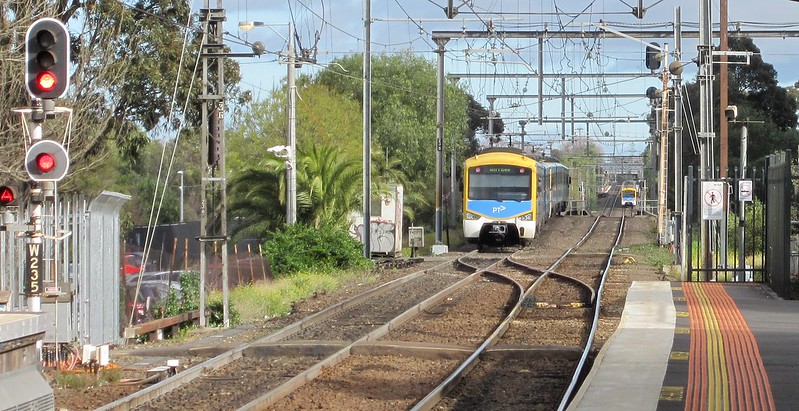You remember how in the old days (pre-COVID), if there was a train delay in peak hour, the next one would be crowded?
What if those delays were baked into the timetable: inconsistent frequencies, with short and long gaps between services?
One way of measuring this is using standard deviation (SD) – the mathematical way of calculating variability – in this case, of the times between trains in the timetable.
A low standard deviation indicates that the values tend to be close to the mean (also called the expected value) of the set, while a high standard deviation indicates that the values are spread out over a wider range.
So the closer the SD is to zero, the more consistent the gaps between trains.
Comparing the old and new timetables, we can see if there’s an improvement. (This is especially relevant given the old/current timetable includes some extra services inserted in odd places into the schedules last year.)
Dandenong and Werribee are usually two of the most crowded lines – and should in theory benefit the most from the timetable changes this time around.
So did they fix the gaps?
Dandenong line
The new timetables take the Frankston line out of the Loop, in part to be able to use that capacity for the Dandenong (Cranbourne/Pakenham) line.
Having Frankston trains sharing the Loop tunnel doesn’t just limit the number of Dandenong trains, it also forces gaps in the service, which leads to uneven frequencies and bad crowding and delays on some trains. This helps clog up both lines.
So do the new timetables use the new capacity effectively?
I compared the old timetable to the new, focusing on evening peak: 4pm to 6:59pm. Given the Loop direction will be changing, I’ve measured the departure times from Richmond, just after the trains have left the CBD.
| Dandenong line peak outbound | Old (2020) | New (2021) |
| Metro trains 16:00-18:59 | 33 | 36 |
| (V/Line trains) | 4 | 4 |
| Smallest gap | 3 mins | 3 mins |
| Biggest gap | 10 mins | 7 mins |
| Average gap | 5.31 mins | 4.89 mins |
| Standard deviation 16:00-18:59 | 2.22 | 1.16 |
| Standard deviation 17:00-17:59 | 1.83 | 1.13 |
As measured by SD, the variation in gaps between trains has improved a lot in the new timetable – both across the full three hour peak, and the “peak of the peak” from 5pm to 6pm. This is a good outcome.
You might expect SD to be lower in the middle of the peak, because that’s the time period when they should be running as many services as possible, with the smallest possible (preferably uniform) gaps.
In the hour either side of this, it’s not unreasonable to have slightly fewer services running – though running consistent high frequency right through the wider peak period helps to spread the passenger load, and this seems to be what they’ve aimed for.
Four PM peak V/Line trains are part of the reason for the larger gaps in this three hour block – a necessity given they share the tracks out as far as Pakenham.
But in the new timetable, they’ve still managed a maximum 7 minute gap between Metro services, rather than the 7-10 minute gaps for V/Line in the old timetable.
Of course this means a slow run for V/Line passengers out of the city – it’s a natural result of track congestion – similar to a motorist who finds clogged roads when departing the CBD at peak hour.
Werribee line
The other line to benefit from Frankston coming out of the Loop is the Werribee line (alongside its close relatives the Williamstown and Laverton/Altona Loop services).
Frankston trains will run through to these lines all the time, which will reduce instances of trains having to terminate and reverse at Flinders Street, meaning a capacity boost. The change has also allowed them to run the Williamstown and Altona Loop services every 20 minutes, instead of the impossible-to-remember 22.
But the Werribee peak express service is the one to look at, as it serves a huge growth corridor in Melbourne’s southwest.
Again looking at 4pm to 6:59pm, and measuring from North Melbourne this time:
| Werribee line peak outbound | Old (2020) | New (2021) |
| Metro trains 16:00-18:59 | 19 | 18 |
| Smallest gap | 4 mins | 10 mins |
| Biggest gap | 14 mins | 11 mins |
| Average gap | 9.72 mins | 10.06 mins |
| Standard deviation 16:00-18:59 | 2.61 | 0.24 |
| Standard deviation 17:00-17:59 | 3.34 | 0 |
One interesting thing here is that there will be one less peak service in the new timetable. This is partly because they’ve moved to a uniform 10 minute frequency (just one service, just before 7pm, is out by one minute from the others).
The uniform frequency means oddities like the 4 minute gap between the 17:13 and the 17:17 (with longer gaps either side) are gone. I’ll wager the 17:13 is usually packed, but the 17:17 is usually fairly quiet.
The SD shows the new service will certainly be much more regular, which is a big improvement.
The question will be (long term) if the 10 minute service is adequate for the patronage at its five main stations: Laverton*, Aircraft, Williams Landing, Hoppers Crossing and Werribee.
*Laverton is also served by Altona Loop trains, but they are less frequent, and slower, so unlikely to be used by many Laverton passengers.
Other lines
Would it be worth measuring standard deviation of gaps between services on other lines? Potentially yes – though it’s the lines with near-uniform stopping patterns that make it meaningful in terms of varying gaps causing crowding.
Lines like Belgrave/Lilydale have other problems. A myriad of stopping patterns (particularly in PM peak), would make this type of exercise very messy. It might be more meaningful to measure at a variety of stations rather than one central point.
I did take a quick look at the Craigieburn line – which had the highest number of crowded trains according to the last load survey in 2019. The SD has barely changed – from 2.04 to 1.98 – with gaps between 5pm and 6pm varying from 4 to 9 minutes. And there are also inconsistent patterns, with the odd train scheduled to bypass the Loop.
Unlike the Dandenong and Werribee lines, there’s limited scope to separate the Craigieburn line out from others (Upfield and Sunbury) and boost services, but the the Metro tunnel will certainly help when it opens in 2025.
Progress for Werribee and Dandenong
This year, HCMTs will start to come into service on the Dandenong line, increasing the capacity per Metro train.
But importantly, the timetable re-write – and the further separation of lines – has led to some welcome consistency on the Dandenong and Werribee lines.
As patronage recovers, this should mean less crowding, and fewer delays.
And – for people travelling at different times through the peak – or connecting from other services – the wait times will also be more consistent.
So while some other lines like Craigieburn don’t have this problem solved yet, this still feels like progress, a big step in the right direction.





4 replies on “Train timetables and mathematics”
Where you have different route lengths, especially short-working, such as Westall and Pakenham, the Westall should operate just ahead of the Pakenham train, then a larger gap, before then next ‘short route’ service operates.
Also, in that above list, especially the Dandenong Corridor, are those frequencies set at Pakenham, Dandenong, or Westall? The frequencies from the city to Dandenong, should be a lot more than that of Flinders Street to Pakenham.
Why must we have a delay in frequency where we have two lines merge or split? Cant be because we need time for the points to move, they take only seconds, and, you can see the tail lights of the train before, reflecting on the points when they change.
Hey Daniel, do you know of any plans to clean up the timetable on the Burnley group? There’s got to be over half a dozen different stopping patterns!
@Jim, there are hardly any peak hour trains that terminate at Westall. In the new timetable, 16:23 and 18:39 outbound from Richmond. That’s it. And they’re not in the busiest part of the peak.
The times were compared at Richmond outbound, as stated in the text.
@Elliot, the grapevine seems to indicate a re-write of the PM Burnley timetable in the next few years, perhaps when Surrey Hills/Mont Albert happens.
Frankston PM Peak is very easy to remember with the new timetable. From Caulfield:
10-minute stoppers up to 1625
1633 stopper followed by a 1636 express, repeated every 10 minutes (both shift one minute later at 1734/1747)
10-minute stoppers 1904-1954
20-minute stoppers 2013-0033 (last service of the night)
If only other lines were so lucky.